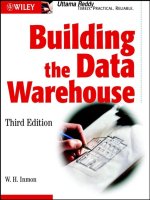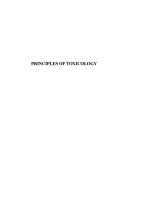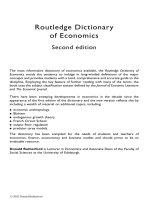International economics 6th edition phần 1 ppt
Bạn đang xem bản rút gọn của tài liệu. Xem và tải ngay bản đầy đủ của tài liệu tại đây (3.94 MB, 55 trang )
International Economics,
Sixth Edition
The latest edition of International Economics improves and builds upon the popular
features of previous editions. The graphs, tables and statistics are of course all updated, but
also added are improved sections on topics including:
• new developments in international trade agreements and the latest round of
international trade talks
• international financial crisis
• a new section on current controversies in the international monetary system
With impressive pedagogy, learning objectives and summaries, this impressive clearly written
book will be another winner with students of international economics and international
business.
Robert M. Dunn, Jr is Professor of Economics at the George Washington University,
USA.
John H. Mutti is Sydney Meyer Professor of International Economics, Grinnell College,
Iowa, USA.
International Economics
Sixth edition
Robert M. Dunn, Jr.
George Washington University
John H. Mutti
Grinnell College
First published 2004
by Routledge
11 New Fetter Lane, London EC4P 4EE
Simultaneously published in the USA and Canada
by Routledge
29 West 35th Street, New York, NY 10001
Routledge is an imprint of the Taylor & Francis Group
© 2004 Robert M. Dunn & John H. Mutti
All rights reserved. No part of this book may be reprinted or reproduced
or utilised in any form or by any electronic, mechanical, or other means,
now known or hereafter invented, including photocopying and recording,
or in any information storage or retrieval system, without permission in
writing from the publishers.
British Library Cataloguing in Publication Data
A catalogue record for this book is available from the British Library
Library of Congress Cataloging in Publication Data
A catalog record for this book has been requested
ISBN 0–415–31153–5 (hbk)
ISBN 0–415–31154–3 (pbk)
This edition published in the Taylor & Francis e-Library, 2004.
ISBN 0-203-46204-1 Master e-book ISBN
ISBN 0-203-33961-4 (Adobe eReader Format)
Contents
List of figures xiii
List of tables xvii
List of boxes xix
List of exhibits xxi
Preface xxiii
1 Introduction 1
Learning objectives 1
Why international economics is a separate field 7
The organization of this volume 8
Information about international economics 10
Summary of key concepts 12
Questions for study and review 13
Suggested further reading 13
PART ONE
International trade and trade policy 15
2 Patterns of trade and the gains from trade: insights from classical theory 17
Learning objectives 17
Absolute advantage 17
Comparative advantage 19
Additional tools of analysis 22
International trade with constant costs 27
International trade with increasing costs 32
The effect of trade 35
The division of the gains from trade 36
Comparative advantage with many goods 41
Summary of key concepts 44
Questions for study and review 45
Suggested further reading 47
Appendix: the role of money prices 47
Notes 49
3 Trade between dissimilar countries: insights from the factor
proportions theory 51
Learning objectives 51
Factor proportions as a determinant of trade 52
Implications of the factor proportions theory 55
Empirical verification in a world with many goods 68
Summary of key concepts 70
Questions for study and review 71
Suggested further reading 72
Appendix: a more formal presentation of the Heckscher–Ohlin model with
two countries, two commodities, and two factors 73
Notes 80
4 Trade between similar countries: implications of decreasing costs and
imperfect competition 82
Learning objectives 82
External economies of scale 84
The product cycle 89
Preference similarities and intra-industry trade 91
Economies of scale and monopolistic competition 94
Trade with other forms of imperfect competition 97
Cartels 101
Further aspects of trade with imperfect competition 103
Summary of key concepts 104
Questions for study and review 105
Suggested further reading 106
Appendix: derivation of a reaction curve 106
Notes 107
5 The theory of protection: tariffs and other barriers to trade 109
Learning objectives 109
Administrative issues in imposing tariffs 110
Tariffs in a partial equilibrium framework 111
Quotas and other nontariff trade barriers 116
Production subsidies 122
Tariffs in the large-country case 123
General equilibrium analysis 124
The effective rate of protection 127
Export subsidies 132
Export tariffs 134
Summary of key concepts 135
Questions for study and review 137
Suggested further reading 138
Notes 138
vi Contents
6 Arguments for protection and the political economy of trade policy 140
Learning objectives 140
Arguments for restricting imports 141
Dumping 154
Secondary arguments for protectionism 158
The political economy of trade policy 161
Summary of key concepts 163
Questions for study and review 164
Suggested further reading 165
Notes 165
7 Regional blocs: preferential trade liberalization 167
Learning objectives 167
Alternative forms of regional liberalization 168
Efficiency gains and losses: the general case 168
Efficiency gains and losses with economies of scale 171
Dynamic effects and other sources of gain 172
The European Union 173
NAFTA 177
Other regional groups 181
Summary of key concepts 181
Questions for study and review 182
Suggested further reading 182
Notes 182
8 Commercial policy: history and recent controversies 184
Learning objectives 184
British leadership in commercial policy 184
A US initiative: the Reciprocal Trade Agreements program 186
The shift to multilateralism under the GATT 187
The Kennedy Round 189
The Tokyo Round 190
The Uruguay Round 191
Intellectual property 197
The rocky road to further multilateral agreements 199
The Doha Development Agenda 200
Expanding the World Trade Organization 200
Summary of key concepts 202
Questions for study and review 202
Suggested further reading 203
Notes 203
9 International mobility of labor and capital 205
Learning objectives 205
Contents vii
Arbitrage in labor and capital markets 206
Additional issues raised by labor mobility 210
Multinational corporations 212
Summary of key concepts 220
Questions for study and review 221
Suggested further reading 221
Notes 221
10 Trade and growth 223
Learning objectives 223
The effects of economic growth on trade 224
Trade policies in developing countries 231
Primary-product exporters 233
Deteriorating terms of trade 235
Alternative trade policies for developing countries 236
Summary of key concepts 239
Questions for study and review 240
Suggested further reading 241
Notes 241
11 Issues of international public economics 242
Learning objectives 242
Environmental externalities 244
The tragedy of the commons 249
Taxation in an open economy 251
Summary of key concepts 259
Questions for study and review 260
Suggested further reading 261
Notes 261
PART TWO
International finance and open economy macroeconomics 263
12 Balance-of-payments accounting 267
Learning objectives 267
Distinguishing debits and credits in the accounts 268
Analogy to a family’s cash-flow accounts 271
Calculation of errors and omissions 273
Organizing the accounts for a country with a fixed exchange rate 274
Balance-of-payments accounting with flexible exchange rates 280
The international investment position table 281
Trade account imbalances through stages of development 285
Intertemporal trade 288
Summary of key concepts 290
viii Contents
Questions for study and review 291
Suggested further reading 291
Notes 292
13 Markets for foreign exchange 293
Learning objectives 293
Supply and demand for foreign exchange 294
Exchange market intervention regimes 295
Exchange market institutions 300
Alternative definitions of exchange rates 302
Alternative views of equilibrium nominal exchange rates 307
Summary of key concepts 308
Questions for study and review 309
Suggested further reading 309
Notes 310
14 International derivatives: foreign exchange forwards, futures, and options 312
Learning objectives 312
Forward exchange markets 312
Foreign exchange options 321
Other international derivatives 325
Summary of key concepts 326
Questions for study and review 327
Suggested further reading 328
Notes 328
15 Alternative models of balance-of-payments or exchange-rate determination 329
Learning objectives 329
Why the balance of payments (or the exchange rate) matters 331
Alternative views of balance-of-payments (or exchange rate) determination 334
Exchange rates and the balance of payments: theory versus reality 348
Summary of key concepts 349
Questions for study and review 350
Suggested further reading 350
Notes 351
16 Payments adjustment with fixed exchange rates 352
Learning objectives 352
David Hume’s specie flow mechanism 352
The Bretton Woods adjustment mechanism: Fiscal and monetary policies 364
The policy assignment model: one last hope for fixed exchange rates 369
Macroeconomic policy coordination 373
Summary of key concepts 374
Questions for study and review 375
Contents ix
Suggested further reading 375
Notes 376
17 Balance-of-payments adjustment through exchange rate changes 377
Learning objectives 377
A return to supply and demand 377
Requirements for a successful devaluation 379
Effects of the exchange rate on the capital account 391
Capital losses and other undesirable effects of a devaluation 392
A brief consideration of revaluations 396
The Meade cases again 396
Summary of key concepts 399
Questions for study and review 399
Suggested further reading 400
Notes 401
18 Open economy macroeconomics with fixed exchange rates 403
Learning objectives 403
The Keynesian model in a closed economy 404
An open economy 410
The international transmission of business cycles 415
Foreign repercussions 416
Some qualifications 417
Capital flows, monetary policy, and fiscal policy 418
Domestic macroeconomic impacts of foreign shocks 425
Domestic impacts of monetary policy shifts abroad 426
Conclusion 427
Summary of key concepts 427
Questions for study and review 428
Suggested further reading 428
Notes 429
19 The theory of flexible exchange rates 430
Learning objectives 430
Clean versus managed floating exchange rates 431
The stability of the exchange market 432
Impacts of flexible exchange rates on international transactions 433
Open economy macroeconomics with a floating exchange rate 434
The domestic impacts of foreign monetary and fiscal policy shifts with
flexible exchange rates 447
Mercantilism and flexible exchange rates 449
Purchasing power parity and flexible exchange rates 451
Summary of key concepts 452
Questions for study and review 453
x Contents
Suggested further reading 453
Notes 454
20 The international monetary system: history and current controversies 455
Learning objectives 455
Events before 1973 456
The Eurocurrency market 459
Floating exchange rates 465
Alternatives to flexible exchange rates 471
The European Monetary Union 473
Changes in the role of the SDR 478
Two decades of developing country debt crises 478
The new financial architecture 486
Sovereign bankruptcy for heavily indebted crisis countries 488
Prospective issues in international economic policy in the next decade 489
Summary of key concepts 491
Questions for study and review 492
Suggested further reading 493
Notes 494
Glossary 496
Index 510
Contents xi
Figures
1.1 Trade goods as a share of GDP in the United Kingdom 1850–1990 3
1.2 The role of foreign direct investment in the world economy (FDI stock
as a percentage of GDP) 4
2.1 Germany’s production-possibility curve 23
2.2 Consumer indifference curves 25
2.3 Equilibrium in a closed economy 28
2.4 Equilibrium with foreign trade 29
2.5 France: equilibrium before and after trade 31
2.6 Increasing costs: equilibrium in a closed economy 33
2.7 Equilibrium trade in a two-country case (increasing costs) 34
2.8 Equilibrium price determination 36
2.9 Derivation of Country A’s offer curve 38
2.10 Offer curves for Countries A and B with the equilibrium barter ratio and
trade volumes 39
2.11 The elasticity of Country A’s offer curve 40
2.12 An empirical demonstration of the relationship between relative labor
productivities and trade 43
3.1 Production with different factor intensities 53
3.2 Patterns of trade given by the factor proportions theory 55
3.3 Growth in the labour force 58
3.4 Isoquants for wheat production 73
3.5 Comparison of factor intensity in cheese and wheat 74
3.6 Box diagrams for Country A. Production-possibility curve for Country A 76
3.7 Influence of factor endowments on the production-possibility curves 78
3.8 Factor price equalization 79
3.9 The Rybczynski theorem 80
4.1 Equilibrium in a closed economy with decreasing opportunity cost 86
4.2 Equilibrium with foreign trade and decreasing opportunity cost 87
4.3 The advantage of a long-established industry where scale economies are
important 88
4.4 The product cycle 90
4.5 Production under monopolistic competition 95
4.6 The impact of free trade on prices: increased competitiveness despite
economies of scale 97
4.7 Reaction curves and duopoly trade 99
4.8 Nominal and real prices of crude petroleum, 1973–2001 (dollars per barrel) 102
4.9 A possible decline in welfare from trade with domestic monopoly 103
4.10 Isoprofit curves and the derivation of a reaction curve 106
5.1 The effects of a tariff: partial equilibrium, small-country case 112
5.2 The effect of an import quota 118
5.3 The effect of a subsidy: partial equilibrium, small-country case 122
5.4 The effect of a tariff: partial equilibrium, large-country case 124
5.5 The effects of a tariff: general equilibrium, small-country case 125
5.6 The effects of a tariff: general equilibrium, large-country case 127
5.7 The effect of an export subsidy 133
5.8 The effect of an export tax 135
6.1 An optimum tariff in a partial equilibrium model 145
6.2 An optimum tariff with offer curves 147
6.3 Subsidization of an oligopoly producer 151
6.4 Dumping can increase profits – an example of price discrimination 155
6.5 Use of a tariff to correct a domestic distortion 160
7.1 Effects of a customs union between France and Germany 169
9.1 Effects of US capital flow to Canada 208
10.1 Neutral growth in a small country 225
10.2 Effect of demand conditions on the volume of trade 226
10.3 Effect of growth on the terms of trade 230
10.4 The case of immiserizing growth 231
11.1 Marginal benefits and marginal costs of pollution abatement 244
11.2 The pollution-income relationship 245
11.3 Tax collections and the terms of trade 253
11.4 A tax on capital in a small country 255
13.1 Supply and demand in the market for foreign exchange 295
13.2 Nominal effective exchange rate for the dollar (1970–2003) 304
14.1 The determination of the forward discount on sterling 318
14.2 Profits and losses from a put option on sterling 323
14.3 Profits and losses from a call option on sterling 324
16.1 Equilibrium in the savings/investment relationship 358
16.2 Equilibrium in the market for money 359
16.3 Equilibrium in the real and monetary sectors 360
16.4 Impacts of fiscal expansion 360
16.5 Impacts of an expansion of the money supply 361
16.6 Equilibrium in the balance of payments 362
16.7 Domestic and international equilibrium 363
16.8 Domestic equilibrium with a balance-of-payments deficit 363
16.9 Balance-of-payments adjustment under specie flow 364
16.10 Payments adjustment through monetary policy 365
16.11 Payments adjustment through a tightening of fiscal policy 366
16.12 Comparing the effects of fiscal and monetary policies 366
16.13 Adjustment of a payments deficit through expansionary fiscal policy 367
16.14 Internal and external balance 370
16.15 Balance-of-payments adjustment through policy assignment 371
16.16 Balance-of-payments adjustments through policy assignment in the
deficit recession case 372
17.1 The market for foreign exchange with a balance-of-payments deficit 378
xiv Figures
17.2 The market for foreign exchange when the local currency is devalued 379
17.3 The Marshall–Lerner case 380
17.4 The Marshall–Lerner case where a devaluations succeeds 381
17.5 The Marshall–Lerner case where a devaluation fails 381
17.6 The small-country case 383
17.7 The larger-country case 384
17.8 The effects of a successful devaluation 389
17.9 The Swann diagram 398
18.1 Equilibrium in a closed economy 406
18.2 The multiplier in a closed economy 409
18.3 The propensity to import and the marginal propensity to import 412
18.4 The trade balance as income rises 412
18.5 Domestic savings, investment, and the S – 1 line 412
18.6 Savings minus investment and the trade balance with both at equilibrium 413
18.7 The impact of an increase in domestic investment 413
18.8 The impact of a decline in exports 415
18.9 Impacts of a decline in exports and an increase in domestic investment 416
18.10 Effects of an expansionary monetary policy with fixed exchange rates 420
18.11 Effects of fiscal policy expansion with perfect capital mobility 423
18.12 Effects of fiscal policy expansion when BP is flatter than LM 424
18.13 Effects of fiscal policy expansion when BP is steeper than LM 424
19.1 Effects of an expansionary monetary policy with fixed exchange rates 439
19.2 Effects of an expansionary monetary policy with a floating exchange rate 440
19.3 Exchange rate overshooting after a monetary expansion 441
19.4 Effects of fiscal policy expansion with perfect capital mobility 445
19.5 Effects of fiscal policy expansion when BP is flatter than LM 445
19.6 Effects of fiscal policy expansion when BP is steeper than LM 446
Figures xv
Tables
1.1 Exports plus imports of goods and services as a share of GNP 2
1.2 International capital flows and trade 6
2.1 An example of absolute advantage 18
2.2 The gain on output from trade with an absolute advantage 19
2.3 An example of comparative advantage 20
2.4 The gain in output from trade with comparative advantage 20
2.5 Domestic exchange ratios in Portugal and England 21
2.6 German production of wheat and steel 23
2.7 German production and consumption 30
2.8 The gain from trade 32
3.1 Differences in factor endowments by country 56
3.2 Differences in factor input requirements by industry 60
4.1 Average intra-industry trade in manufactured products 93
5.1 Employment in the steel industry 115
5.2 The US market for steel mill products 116
5.3 The Japanese price gap 121
5.4 Tariff escalation in the textile and leather sector 128
5.5 The economics of Indonesian bicycle assembly 131
6.1 Dumping cases in the United States and European Community, 1979–89 157
7.1 European Union trade, 1988 and 1994 175
7.2 Projected gains from completion of the internal market 176
7.3 EU operational budgetary balance, 2000 177
7.4 US trade and employment by SIC industries 180
8.1 Average tariff rates in selected economies 191
8.2 Tariff bindings and applied tariffs 193
8.3 Cases brought for WTO dispute resolution in 2002 196
9.1 The role of immigrants as a share of the population or work force 206
9.2 The top 25 global corporations 214
10.1 Leading Malaysian exports, 1965 and 1995 228
10.2 Trade of developing countries 232
10.3 Concentration of merchandise exports for least developed countries 234
11.1 Tax revenue as a percentage of GDP, 2000 251
11.2 Corporate income tax rates on US manufacturing affiliates 257
11.3 Taxes on corporate income as a percentage of GDP, 1965–2000 257
15.1 Impact on the domestic money supply of a balance-of-payments deficit 332
15.2 The sterilization of effects of a payments deficit 332
19.1 Strength of fiscal policy in affecting GNP under alternative exchange
rate regimes 446
19.2 Summary of open economy macroeconomics conclusions 451
20.1 The creation of a Eurodollar deposit 460
20.2 A Eurodollar redeposit 461
20.3 Exchange rate regimes of IMF members as of 31 December 2001 466
xviii Tables
Boxes
2.1 Offer curves 38
3.1 How different are factor endowments? 56
3.2 How different are factor intensities? 59
3.3 The widening income gap: is trade to blame? 63
3.4 An intermediate case: a specific factors model 67
4.1 Intra-industry trade: how general is it? 92
4.2 Further reasons for economies of scale: the learning curve 98
5.1 How do economists measure welfare changes? 114
5.2 World steel trade – a case of permanent intervention? 115
5.3 Super sleuths: assessing the protectiveness of Japanese NTBS 121
5.4 Tariff escalation and other complications 128
5.5 Effective rates of protection and the Indonesian bicycle boom 131
5.6 EU sugar subsidies and export displacement 134
6.1 Optimum tariffs: did Britain give a gift to the world? 146
6.2 Another view of the optimum tariff: offer curve analysis 147
6.3 Semiconductors and strategic trade policy 153
7.1 Fortress Europe? 175
7.2 A NAFTA scorecard 179
8.1 Tariff bindings and applied tariffs 193
8.2 WTO dispute resolution and the banana war 195
8.3 Pharmaceutical flip flops and the TRIPS agreement 197
8.4 Who’s afraid of China? 201
9.1 Mergers, acquisitions and takeovers: hold the phone 216
10.1 Malaysia’s changing pattern of trade 227
10.2 Sustaining growth and economic miracles 228
10.3 The terms-of-trade effects of growth: offer curve analysis 230
10.4 An overview of developing-country trade 232
10.5 Measuring economic development: the NIKE index 239
11.1 Trade in toxic waste 246
11.2 Wealth of the Irish 258
12.1 Gold as a reserve asset 270
13.1 The Bic Mac index 306
15.1 Modeling the monetarist view of the balance of payments 345
15.2 Printing the budget deficit as a route to inflation 346
16.1 The IS/LM/BP graph as a route to understanding balance-of-payments
adjustment 357
16.2 IS/LM/BP analysis of adjustment under the Bretton Woods system 365
16.3 The IS/LM/BP graph for the policy assignment model 372
17.1 IS/LM/BP analysis of a devaluation 388
17.2 The “success” of Mexico’s 1994–6 adjustment program 393
18.1 Japan’s chronic current account surplus: savings minus investment 414
18.2 IS/LM/BP analysis of monetary policy with fixed exchange rates 420
18.3 IS/LM/BP graphs for fiscal policy under fixed exchange rates 423
18.4 Impacts of an expansion abroad with extensive capital market integration 425
18.5 Macroeconomics expansion abroad with little capital market integration 426
18.6 Impacts on Canada of a tighter US monetary policy 427
19.1 Canadian monetary policy in mid-1999 438
19.2 IS/LM/BP analysis of monetary policy under floating exchange rates 439
19.3 IS/LM/BP analysis of fiscal policy with floating exchange rates 444
20.1 Argentina: snatching defeat from the jaws of victory 485
xx Boxes
Exhibits
12.1 US balance of payments summary 276
12.2 UK balance of payments in the IMF format 279
12.3 US international transactions 1993–2001 282
12.4 International investment position of the United States 1994–2001 284
12.5 UK international investment position 285
13.1 Exchange rates 303
13.2 Real effective exchange rate indices 305
14.1 Exchange rates: spot and forward 313
14.2 Exchange rate futures 314
14.3 Foreign exchange options 322
19.1 Why is the Fed suddenly so important? 436
19.2 Save an auto worker’s job, put another American out of work 449
20.1 One currency, but not one economy 475
20.2 $40 billion for Wall Street 481
Preface
This book is an introduction to international economics, intended for students who are
taking their first course in the subject. The level of exposition requires as a background no
more than a standard introductory course in the principles of economics. Those who have
had intermediate micro and macro theory will find that background useful, but where the
tools of intermediate theory are necessary in this book they are taught within the text.
The primary purpose of this book is to present a clear, straightforward, and current
account of the main topics in international economics. We have tried to keep the student’s
perspective constantly in mind and to make the explanations both intuitively appealing and
rigorous.
Reactions from users of the first five editions – both students and faculty – have been
encouraging. The passage of time, however, erodes the usefulness of a book in a constantly
evolving area such as international economics, and we have consequently prepared a sixth
edition.
The book covers the standard topics in international economics. Each of the two main
parts, International Trade and Trade Policy (Part One) and International Finance and Open
Economy Macroeconomics (Part Two), develops the theory first, and then applies it to
recent policy issues and historical episodes. This approach reflects our belief that economic
theory should be what J.R. Hicks called “a handmaiden to economic policy.”
Whenever possible, we use economic theory to explain and interpret experience. That is
why this book contains more discussion of historical episodes than do most other inter-
national economics textbooks. The historical experience is used as the basis for showing how
the theoretical analysis works. We have found that students generally appreciate this
approach.
This is the second edition of this book with John Mutti as co-author and with Routledge
as the publisher. John Mutti replaced James Ingram, who is now Emeritus at the University
of North Carolina, Chapel Hill, who authored the first two editions alone, and who co-
authored the next two with Robert Dunn. Both authors of this edition would like to express
their great appreciation for the help which Jim Ingram provided, including his permission
to carry over some material which he wrote for previous editions. It would have been
impossible to continue this project without Jim’s help, and his spirit and many of his
concepts remain central to the book.
Changes in the coverage of international trade
In the first half of the book some important changes in the presentation of conceptual
material should be noted, in addition to the inclusion of several more recent developments
in commercial policy and multilateral trade negotiations. Chapter 3 pays greater attention
to common extensions of the Heckscher–Ohlin framework for analyzing patterns of trade.
It gives a more systematic presentation of the effects on patterns of production from growth
in factor endowments, and it addresses the conditions for factor price equalization more
formally. Chapter 5 extends the analysis of tariffs to consider tariff escalation and tariff-rate
quotas, and it assesses US safeguard protection in the steel industry and EU export subsidies
for sugar.
Following the treatment of arguments for protection in Chapter 6, the order of the next
three chapters changes. Chapter 7 now presents the analysis of regional trade blocs. The
decision of the European Union in 2002 to offer membership to ten additional countries
raises several important issues of governance and economic policy that are discussed there.
With respect to the North American Free Trade Agreement, because a longer time frame
is available to observe the consequences of its creation, the scope of adjustments faced by
US industries is put in better perspective. Chapter 8 now reviews world commercial policy.
It especially notes significant issues that arose in initiating the Doha Development Round
of multilateral trade talks in 2001, and it notes others that will be addressed in the nego-
tiations. Chapter 9 now covers issues of capital mobility, immigration, and multinational
corporations.
Chapter 10 on trade and growth pays particular attention to the position of the least
developed countries. Chapter 11, which discusses issues of public economics, notes the
advance of the Kyoto Protocol to the Climate Change Convention, in spite of US
opposition, and the success of the Irish in international tax competition.
Changes in the discussion of international finance and open economy
macroeconomics
First, all graphs and tables have been updated to what was available in early 2003. Within
Chapter 12, the coverage of intertemporal trade has been moved forward from an appendix
into the main text. The discussion of what assets constitute foreign exchange reserves has
been extended, and the discussion of the IMF format for the balance of payments accounts
made more thorough. In Chapter 13 the discussion of various means of evading exchange
controls has been made far more complete, and now includes a discussion of hawala banking.
The fact that all of these techniques are relevant for criminal or terrorist groups which wish
to move money in undetected ways, makes this topic of greater importance than it was before
September 11, 2001.
In Chapter 14 the discussion of foreign exchange options, which some readers found to
be confusing, has been rewritten and extended, with an emphasis on intrinsic and time
values in determining premiums on foreign exchanged puts and calls. In Chapter 16, the
treatment of currency boards has been extended, with an emphasis on why Argentina’s
institution failed. Dollarization is also covered more thoroughly. Chapter 17 now includes
far more on the disastrous effects of currency mismatches when a country devalues. If banks
and other firms in a country have large liabilities denominated in foreign exchange without
offsetting foreign exchange assets of other forms of cover, a devaluation can produce a wave
of insolvencies and create something approaching a depression, as Argentina discovered very
unhappily. The diagram developed by Trevor Swann to analyze a devaluation has been
added at the end of this chapter, with the accompanying discussion emphasizing how both
the exchange rate and domestic macroeconomic policies must be adjusted to produce both
payments equilibrium and an acceptable level of GDP. In Chapter 19, the “impossibility
xxiv Preface









